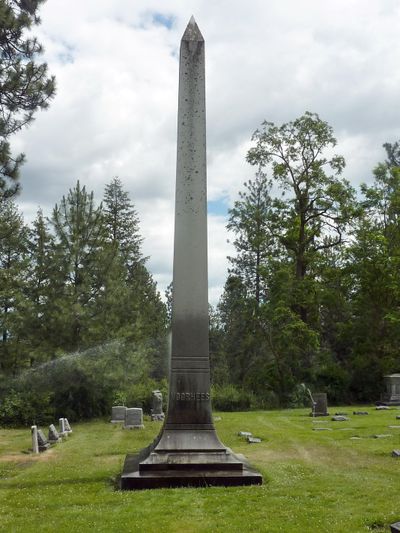Landmarks: Obelisk marks gravesite of Spokane pioneer Charles Voorhees

A tall obelisk in the pioneer section of Greenwood Memorial Terrace marks the place where Charles Stewart Voorhees and some of his family members are buried. Voorhees holds two significant distinctions.
The first has to do with Washington’s statehood, and the second puts him in the company of a select few national notables, including the late Sen. Ted Kennedy of Massachusetts.
Voorhees was born in Indiana in 1853 and practiced law in Terre Haute before moving to Washington Territory in 1882, settling in the community of Colfax. He served as the prosecuting attorney for Whitman County from 1882-1885, and then, running as a Democrat, was elected as a territorial delegate to the U.S. Congress, serving from 1885 to 1889. It was during his time in Congress that the Enabling Act was passed. This created the pathway for Washington to become a state in 1889.
After losing his re-election bid, Voorhees returned briefly to work as an attorney in Colfax, then moved his law practice to Spokane in the same year Washington became a state. In his “History of the Spokane County Bar and Bench,” Benjamin H. Kizer wrote that Voorhees had more legal business than he could handle, so in 1897 he asked his brother Reese to join him from Indiana. Together they formed the Voorhees and Voorhees law firm, where the brothers practiced until Charles’ death in 1909. It was then that Reese Voorhees asked former Whitman County Superior Court Judge Henry Canfield to join him, and the firm became Voorhees and Canfield.
However, it was Charles Voorhees’ relationship with his father, Daniel W. Voorhees, that gives him a special position in American politics.
The senior Voorhees, known as Indiana’s “Tall Sycamore of the Wabash,” was also an attorney and an active Democrat with political ambitions. He was a member of the group known as the Copperheads, a vocal faction of northern-state Democrats who opposed the Civil War. One historical account states that even though they had significant political differences, he and Abraham Lincoln knew each other from their circuit riding days and remained friends throughout Lincoln’s life.
After first serving in the U.S. House of Representatives, Daniel Voorhees was elected to the U.S. Senate and served 1877-1897, where he chaired the important finance committee and was noted for his fine oratory. He played an active part in building a new Congressional Library.
There are several fathers and sons who followed each other in serving in the U.S. Senate or House of Representatives, but very few who served at the same time. Charles Voorhees was in Congress for four of the 20 years that his father served in the Senate – one of only four pairs of fathers and sons serving simultaneously.
One of the other Senate-House pairs is Sen. Ted Kennedy, serving from 1962 until his death in 2009, and his son Rep. Patrick Kennedy of Rhode Island, who served 1995-2011. Another is Sen. Rand Paul of Kentucky, 2011-present, and Rep. Ron Paul of Texas, who served many terms in the House and overlapped with his son his last two years in office from 2011-2013. The fourth pair served in the Senate – Henry Dodge of Wisconsin, serving 1848-1857, and his son Augustus Dodge of Iowa, who served 1848-1855.